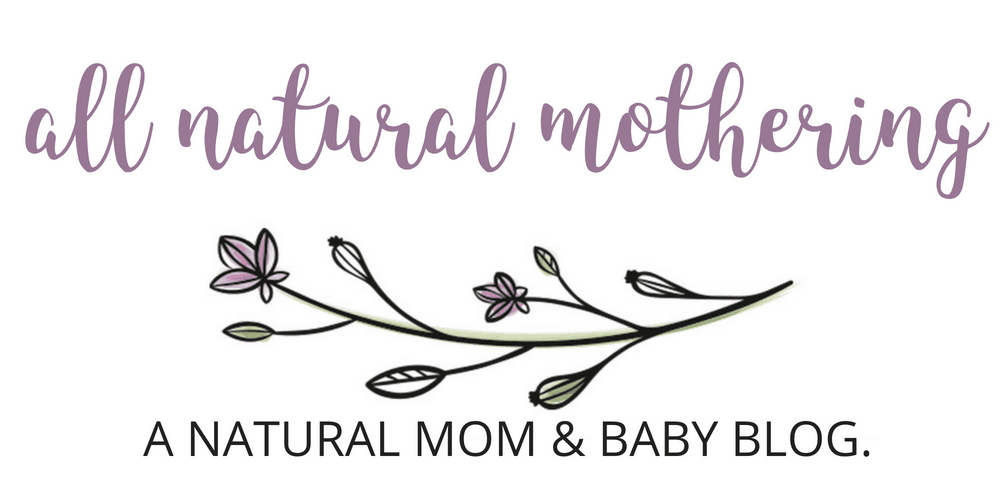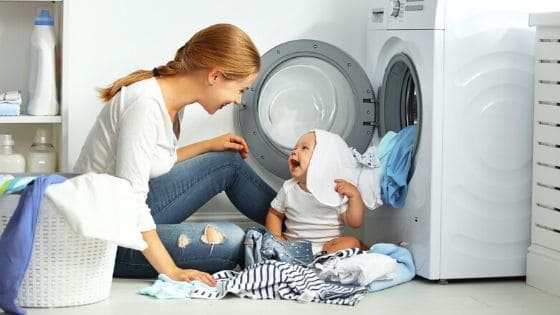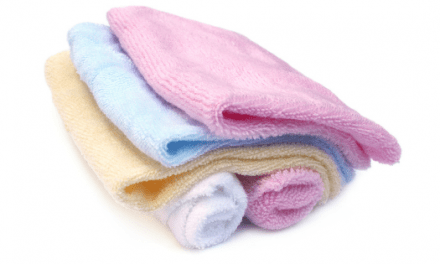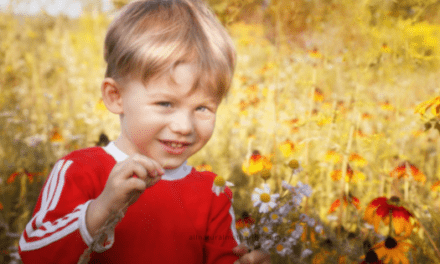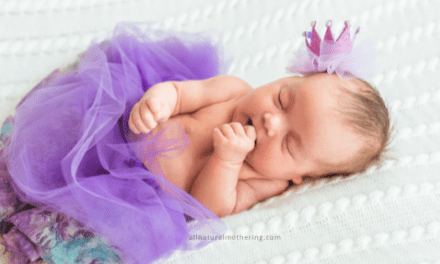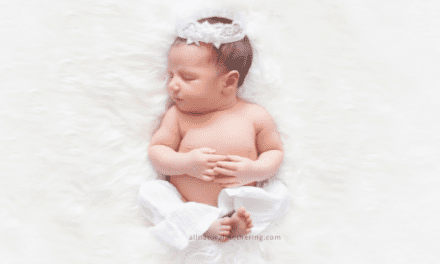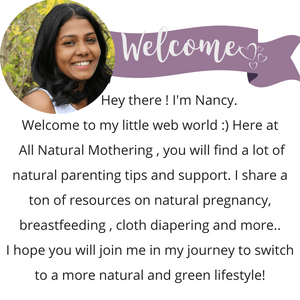Ah, the skin of your little one. Does it feel like velvet, silk, or just pure air?
Sometimes it?s hard to decide, but one thing is for sure – it?s untainted by the effects of aging and the environment.
As moms, we want to keep it that way for as long as possible. But too often we see our babies struggling with itchy little patches of eczema, dry skin, and redness.
Mainstream baby detergents often contain harsh chemicals, but trying to determine which ones to avoid can be overwhelming.
Even products that are marketed specifically for babies often contain ingredients that have been scientifically implicated as harmful to human health.
So how do we keep that precious baby skin clean and safe while also effectively cleaning our baby?s clothes? By choosing baby detergents that are natural, non toxic and free of harmful chemicals.
Why use baby laundry detergent?
While they may seem unnecessary, baby laundry detergents have an important use for cleaning dirt, food, spit up, and even soiled shorts (Eventually, we have to potty train them!).
There can also be dead skin from cradle cap or blood from scraped knees and elbows.
But not all detergents are created equal, and newborn babies have particularly fragile skin as they haven?t had time to adjust to life outside the womb.
It?s important to keep the fabrics against their bodies clean, but many detergents are too powerful and leave residue from chemical ingredients that are meant to give clothing a ?clean smell? or ?bright look.?

What are the risks of using mainstream detergents to wash baby clothes?
Let?s discuss this information through the lens of empowering you rather than scaring you!
In a consumerism market with excellent branding and marketing, it?s often hard to know what?s real.
Most mainstream laundry detergents contain endocrine disruptors and cancer-causing agents, even if they claim to be ?free,? ?pure,? or ?gentle.?
These detergents may actually contain a chemical that masks the smell of the other chemicals, so ?free & gentle? appears that way simply because there?s no smell!
A report by the U.S. Department of Health and Human Services also shows that mothers pass toxins to their babies through pregnancy and breast milk.
So it?s important to find a detergent that is not only safe for your baby but is safe for the whole family.
Not to mention that delicate fabrics can be worn down with harsh detergents, causing your baby?s clothing to be less soft and elastic. You want a detergent that is safe but also effective at gently cleaning clothes.
- Harsh chemicals
The words ?harsh chemicals? have been tossed around a lot lately.
And if we?re honest, we?re skeptical as to how much we can actually avoid them. Some chemicals, which we?ll discuss below, are known to be carcinogens, endocrine disruptors, allergens, and hazardous to the environment.
When present in detergents, they can rub off on baby?s skin, be inhaled through their little noses, and seep into car seats, blankets, and loveys as they sweat or become wet.
Some chemicals are persistent enough to remain in your washer even after multiple rinses – so they touch everything you touch.
- Skin sensitivities
There are usually two different reactions to harsh baby detergents – irritation or allergic contact dermatitis.
Your baby can actually be exposed to an allergen many times before their body develops an immune response.
A good way to tell if your detergent is causing a problem is to switch to a natural laundry detergent for sensitive skin and see if rashes and/or redness clear up within a couple of weeks. (Keep reading for the best selection of natural baby detergents!)
Common (but problem) detergents
Tide
I remember my mom using Tide on our clothes as kids. Many moms loved the promises for clean and tid(e)y laundry, as well as the ?fresh? scent!
Almost by rule of thumb, Tide detergents receive a D rating (high concern) on the EWG website.
Surprisingly, the versions of Tide that you think would be more safe actually earn a similar rating.
Tide Free & Gentle, for example, receives a D rating for ?poor disclosure? and may contain masking agents to cover the scent from other ingredients. Tide Pure Essentials actually receives an F rating. Yikes!
Dreft
On the EWG rankings, Dreft comes in with an F rating. This surprised me as Dreft is specifically known as a hypoallergenic detergent safe for babies with eczema.
Why the low rating?
Most of the ingredients have a C or below rating, which means they pose moderate to severe health concerns.
One such ingredient, sodium borate, is associated with reproductive, developmental and endocrine disruption. Likewise, diethylene glycol and ethanolamine also affect systemic and organ functions.
There are even a few known carcinogens – the very ones have a C (moderate cause for concern) rating from the EWG.
All:
I think All commercials are probably some of the best laundry detergent commercials I?ve ever seen. They?re family-oriented with a cute baby or playful puppy, and the background music is almost soothing.
I really wanted All to be one of the good ones; sadly, many of their products receive an F rating from the EWG.
All Free & Clear is rated F for high concern regarding developmental and reproductive toxicity and some concern for cancer, asthma, and skin allergies. It?s worth noting that any detergent with ?poor ingredient disclosure? is probably worth a pass!
Here is a table of some of the popular mainstream laundry detergents and their EWG rating.
5 steps to choosing the best baby-safe detergent:
1.Look at the EWG?S rating chart
While some baby detergents claim to be ?organic,? ?free,? or ?hypoallergenic,? the branding is often misleading. Of course, the frequency of exposure to these ingredients is just as important. Because we wear clothing everyday, this means daily exposure to whatever residue our detergent left behind.
What about laundry detergents made by green brands like Babyganics and Seventh Generation?
Babyganics 3X Laundry Detergent
With a name like Babyganics, it?s easy to assume that this is a safe product for your baby (the word ?baby? is literally in the title)!
However, the EWG gives this detergent an F rating based on the inclusion of sodium borate and methylisothiazolinone as cleaning agents.
Both are given moderate concern for developmental and reproductive toxicity.
Seventh Generation
I know Seventh Generation to be a trusted brand, and while all of their products do not receive an A rating, their laundry detergent does!
However, there is some concern for carcinogens and respiratory illness due to non-specific ingredient disclosure of fatty and methyl ester ethoxylates.
Nonetheless, an A rating indicates a safe choice with little cause for concern. But are there better baby detergents out there? Yes! we have picked the best non toxic laundry detergents for your baby (keep reading!)
Here is a table of some of the green baby laundry detergents and their EWG rating.
2.Read the labels and look for harmful ingredients
Perhaps one of the most important things to note about harsh chemicals is that many of them are persistent and don?t wash away easily.
Even in wastewater treatment, some chemicals remain active. Imagine how long they can linger in your baby?s clothing!
1,4-dioxane – Doesn?t wash away or degrade easily, so it sticks around in your fabrics (and the environment) for a long time. The International Agency for Research on Cancer lists 1,4-dioxane as a possible human carcinogen.
Chlorine bleach (Sodium hypochlorite) – I have memories of walking into my grandmother?s house and smelling the scent of bleach after she?d cleaned. It was (and is) very effective at whitening and killing germs.
But it is also more dangerous than we realized.
The EWG ranks it high concern for skin allergies and irritation and moderate concern for asthma.
If you need to deep clean, look for a chlorine-free version like this one made by Seventh Generation or even better use peroxide.
Dyes, or Artificial colorants, are often petroleum-based chemicals which are known endocrine disruptors and carcinogens, as well as toxic to our water supply and the environment.
Moreover, they don?t add any cleaning power to laundry detergents. They?re simply meant to make the laundry detergent look pretty.
Other chemicals must also keep they dyes from leaching into your fabrics when being washed.
Ethylene oxide – This is definitely an ingredient you?ll want to avoid when choosing your baby?s detergent
. At least 5 major organizations linked to cancer research, including the World Health Organization (WHO), have classified ethylene oxide as a known human carcinogen, and it has the highest possible rating for cancer concern from the EWG.
The EPA also labels it as toxic to the respiratory system and irritating to the eyes and skin.
Formaldehyde – For years, formaldehyde found its main purpose in the funeral industry (as a preservative in embalming fluid).
Nowadays, it lurks in many of our products for the purpose of enhancing smell. This toxic chemical is linked to cancer, damage to the central nervous system, and respiratory illness.
The EPA identifies it as a probable human carcinogen. It may also appear on a label by the name formalin.
Fragrance – Using the word ?fragrance? in detergent is similar to companies using the words ?natural flavor? in foods. No one really knows what it means!
It?s a sneaky way to add unsafe ingredients which then fly under the radar.
The EWG gives fragrance a high concern priority for allergies and immunotoxicity. Products with fragrances are linked to hormone disruption, asthma attacks, and diabetes.
?Natural? or ?organic? fragrances are also worth avoiding because they are often processed with solvents rather than distilled, making them just as harmful as synthetic fragrances.
Nonylphenol ethoxylates (NPEs) – This is a group of petrochemicals that are known to mimic hormones and cause confusion on a cellular level.
They are commonly nicknamed ?gender bender? chemicals for their effects on the reproductive system!
Optical brighteners – Think of optical brighteners like bicycle reflectors. They intentionally cling to fabrics in order to reflect light and make clothes appear brighter.
Also known as OBAs (Optical Brightening Agents), frequent use irritates the skin and makes it sensitive to sun exposure.
If you scan a black light against clothing washed in OBAs, the fabric actually glows! On the same turn, OBAs make dark clothes appear lighter too – in other words, old and faded (which no one wants).
Petrochemicals – Following the effects of World War II, scientists discovered they could create synthetic chemicals from petroleum to replace natural ingredients (and also never run out!).
But buyer beware: these chemicals will be listed in the ingredients by other names. Refer to the EWG website for a list or use one of the green detergents covered in this article.
Phosphates – You know the foaming action you often see as you clean? That?s mostly due to phosphates! These suds increase the cleaning power of your detergent, but they also cause damage to the environment, respiratory illness or allergies, and skin irritation.
Phthalates – These are the one of the sneakiest and therefore more difficult to avoid, but one sure fire way is to avoid products with the word ?fragrance? as many phthalates can be masked with this word.
These chemicals are linked to unnatural hormone changes, diabetes, obesity, and thyroid disruption. Most notably, they trigger the early death of testicular cells.
Sodium lauryl sulfate (SLS) and Sodium laureth sulfate (SLES) – At first glance, SLS and SLES can appear safe for use.
This report indicates that SLS has ?statements in the media that are not scientifically supported.?
The EWG gives sodium lauryl sulfate a ?fair? rating subject to concentration or use limitations. However, some studies show that SLS is linked to skin irritability, and ?irritation on contact with skin, eyes, or mucous membranes.?
SLES, on the other hand, causes more serious concern.
The EWG lists that there are ?contamination concerns? with this surfactant, including 1,4-dioxane and ethylene oxide (two of the big bads discussed previously).
Both SLS and SLES are classified on the Environment Canada Domestic Substance List as ?expected to be toxic or harmful to non-reproductive organs.? Interestingly, these are often found in products which claim to be ?hypoallergenic.?
When in doubt, look at the EWG ratings! This group has done the work for you, so you don?t need to stress about reading the label of every detergent on the shelf.
3.Choose fragrance free
Baby?s clothes don?t need to smell like a tropical rainforest or summer breeze (whatever those things smell like).
They need to be clean, fresh, and safe for their skin and bodies.
If a detergent leaves a scent, that means it left residue on your baby?s clothes.
The only thing your baby?s clothes should smell is clean
4.Pay attention to ?hypoallergenic?
Look for ?hypoallergenic? on the label, but also keep in mind that this one is tricky. Not all baby detergents that claim to be hypoallergenic use ingredients that are safe.
Compare to the list above, paying careful attention for SLS and SLES.
5.No optical brighteners
As mentioned previously, OBAs are best avoided altogether as they only make clothes appear brighter by leaving a lingering light-reflecting chemical on fabrics.
Best baby-safe detergent powder
Typically, liquid detergent is preferred over powder because it washes out more easily, and therefore, is more ideal for sensitive skin.
But some of the best and safest baby detergents on the market come in tablet or powder form.
1.Molly?s Suds
Created by a pediatric nurse and mom of 4, one of the goals of Molly?s Suds is to be ?safe for even your tiniest family member.?
Molly?s Suds ingredients are earth and plant-derived, and they are also certified vegan and cruelty-free. Molly’s Suds in our top natural laundry detergent pick for your baby.
Molly?s uses Carboxymethyl Cellulose (a.k.a. Cellulose Gum) as the primary ingredient, and it receives an A rating from the EWG. It can actually be found in food items such as ice cream and toothpaste!
It works by creating a negatively charged barrier to the filth on your clothes. In other words, the dirt is literally suspended in the water then washed away!
Molly?s Suds original version contains peppermint oil, but if you are sensitive to peppermint, an unscented version is offered. Molly?s also offers an oxygen whitener and a special detergent for cloth diapers!
2.Rockin? green
Another green brand is Rockin? Green detergent developed with the mission to ?create green cleaning products that are hard-working to meet the demands of every family, gentle on sensitive skin, AND earth-friendly.?
This brand is free of over 12 additives normally found in mainstream detergents, including the ones we know to be endocrine disruptors and carcinogens.
They also have special detergents for washing cloth diapers.
Best Detergent Liquid
1.Branch Basics
Branch Basics was created by a three-woman team who experienced their own healing and recovery after switching to a more green and natural lifestyle.
They guarantee products that are plant and mineral-based and leave no toxic residue, plus have stain fighting power for your baby?s clothes. The EWG gives this natural detergent an A rating!
2.Better Life
The unscented version specifically has an A rating from the EWG. It?s formulated with plant-derived ingredients and claim that ?what?s gentle on your clothes is also gentle on your skin.?
Their scented version also receives an A rating and is made with natural oils, but it does pose some concern for respiratory effects and skin allergies or irritation.
3.Charlie?s Soap – A rating
A-rated Charlie?s Soap has been around for a while. Another thing to love about Charlie?s Soap is that they are a family-run company.
The soap was originally created to clean textiles machines while also being safe for the ?little old ladies? who ran them. It turned out that it was also effective and safe for washing dirty clothes, and the demand for Charlie?s Soap grew. Over time, it has become a leading brand in all-natural detergents.
The surfactants in Charlie?s Soaps are 100% plant-based, environmentally friendly, and have a biodegradability rate of 98%. Charlie?s even qualifies for the EPA?s safer choice standard.
Laundry accessories to avoid
1.Fabric softeners
Fabric sheets often have ambiguous labels but are known to house harsh chemicals. If you prefer to use something to soften your fabrics, wool dryer balls are a safe alternative to use in the dryer.
You don?t have to pull them out between loads, and in the long run, they are more affordable than dryer sheets or fabric softener because they can be reused. They also have the added benefit of cutting down on your cycle time!
2.Dryer sheets
Anti-static products (think dryer sheets) are best to avoid as they contain potent chemicals. Products like Bounce (even free and sensitive) are given a D rating from the EWG for ingredients known to cause respiratory problems and skin allergies. Even the ?safer? brands like Grab Green and 365 Everyday receive C ratings for the same concerns.
The most natural and non toxic option is to use wool dryer balls like this one.
3.Stain removers
Stain remover gels and pens generally contain several harsh chemicals, many of them undisclosed on packaging. For example, Shout! Products – known for their stain-fighting power – are given a rating of D or lower from the EWG.
Even Seventh Generation Stain Remover receives a C rating for moderate concerns about skin, respiratory effects, and environmental harm.
If you do need something that?s tough on stains, try sunning your baby clothes. It is a natural bleach. When that doesn’t work try this one from Molly’s Suds.
VIII. Conclusion
It doesn?t take harsh ingredients to clean your baby?s clothes. Laundry detergent simply needs to lift the dirt from your fabrics and suspend it in water long enough for the rinse cycle to take it away.
Additives like brighteners, softeners, and fragrances actually remain in your clothes and mask dirt and odor. And wouldn?t we much rather have truly clean clothes?
Ultimately, you can take other precautions to keep your baby?s skin safe, such as using the extra rinse cycle on your washing machine to make sure that even the safest of ingredients are washed from your baby?s sweet, little clothes. The best things in life are free…and clean!
